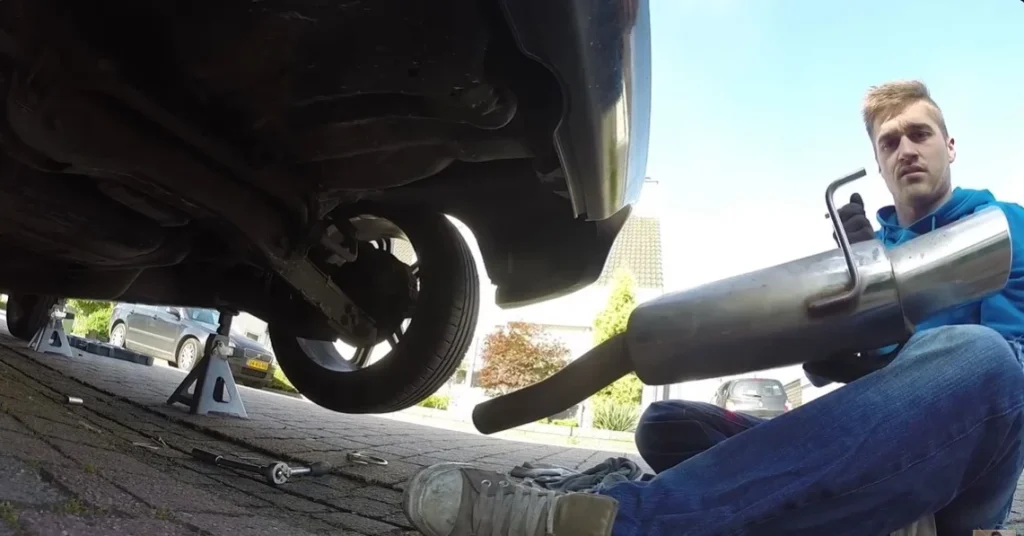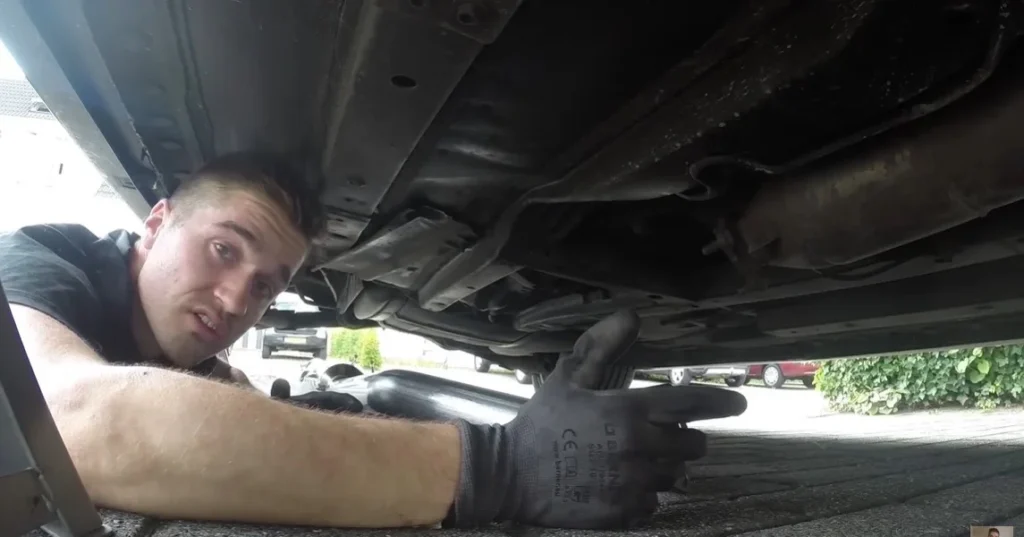To install a performance car exhaust system, remove the old exhaust and fit the new one in its place. Ensure all connections are secure and properly aligned.
Upgrading to a performance car exhaust system can enhance your vehicle’s power, sound, and efficiency. This modification is popular among car enthusiasts looking to boost their engine’s performance and achieve a more aggressive exhaust note. By replacing the stock exhaust with a high-performance option, you can reduce back pressure and increase horsepower.
The installation process typically involves basic tools and mechanical knowledge. This guide will help you understand the steps to install a performance exhaust system correctly. Always ensure you have the necessary tools and safety equipment before starting.

Choosing The Right Exhaust System
Installing a performance car exhaust system can greatly enhance your vehicle’s power and sound. Choosing the right exhaust system is the first step. This section will guide you through different options and materials to help you make an informed decision.
Types Of Exhaust Systems
There are several types of exhaust systems to consider:
- Cat-Back Exhaust: This system replaces the exhaust from the catalytic converter to the back of the car.
- Axle-Back Exhaust: This system replaces the exhaust from the rear axle to the back of the car.
- Header-Back Exhaust: This system replaces the entire exhaust from the headers to the back of the car.
Materials And Durability
The material of your exhaust system affects its durability and performance:
| Material | Durability | Performance |
|---|---|---|
| Aluminized Steel | Moderate | Good |
| Stainless Steel | High | Excellent |
| Titanium | Very High | Exceptional |
Aluminumized Steel is cost-effective but may rust. Stainless Steel offers high durability and resistance to rust. Titanium is lightweight and offers the best performance but at a higher cost.
Necessary Tools And Equipment
Installing a performance car exhaust system can boost your vehicle’s power and sound. To start, you’ll need the right tools and equipment. This ensures a smooth and safe installation process. Below, we’ll cover the essential tools and safety gear you need.
Basic Hand Tools
A successful exhaust system installation requires several basic hand tools. These tools help you remove the old exhaust and install the new one.
- Socket set: Various sizes for different bolts.
- Wrenches: Open-end and box-end wrenches.
- Screwdrivers: Both flat-head and Phillips.
- Pliers: Needle-nose and standard pliers.
- Rubber mallet: To gently tap parts into place.
Safety Gear
Safety is very important during an exhaust system installation. Proper gear protects you from potential hazards.
- Safety glasses: Protect your eyes from debris.
- Gloves: Keep your hands safe from sharp edges.
- Ear protection: Reduce noise levels during the installation.
- Face mask: Prevents inhalation of harmful particles.
- Jack stands: Secure the vehicle above the ground.
With these tools and safety gear, you are ready to start. Proper preparation makes the process easier and safer.

Preparing Your Vehicle
Getting ready to install a new performance car exhaust system takes careful steps. This part of the process ensures your safety and the success of the installation. Begin by making sure you have all the necessary tools and a clear workspace.
Lifting The Car
First, lift your car to provide enough space to work. Using a hydraulic jack is highly recommended for safety.
- Place the jack under a sturdy part of the car’s frame.
- Lift the car slowly until it’s high enough to work underneath.
- Secure the car with jack stands to prevent it from falling.
Always double-check the car’s stability before you proceed. Safety is the top priority during this step.
Removing The Old Exhaust
Once the car is secure, you can start removing the old exhaust system. This involves several steps to ensure proper removal:
- Locate the exhaust bolts and use a wrench to loosen them.
- Remove the bolts carefully and set them aside.
- Detach the exhaust hangers using pliers or a hanger removal tool.
- Slide the old exhaust system out from under the car.
Keep all parts organized to avoid losing any critical components. Having a table or tray nearby can help with this.
After removing the old exhaust, inspect the car’s undercarriage. Check for any damage or wear that might affect the new exhaust system. Fix any issues before proceeding with the installation.

Fitting The New Exhaust
Installing a performance car exhaust system can greatly enhance your car’s power and sound. This section will guide you through fitting the new exhaust. Follow these steps to ensure a proper and secure installation.
Aligning The Parts
Begin by aligning the new exhaust parts with the existing mounting points on your vehicle. This step is crucial for a seamless fit and optimal performance.
Steps to Align the Parts:
- Place the new exhaust system under the car.
- Use a jack to lift and support the exhaust in place.
- Ensure all mounting points line up correctly.
- Adjust the position if necessary for a perfect fit.
Double-check the alignment before moving on to the next step. Misalignment can cause performance issues and noise.
Securing The Connections
Once the parts are aligned, it’s time to secure all connections. This ensures the exhaust system stays in place and functions properly.
Steps to Secure the Connections:
- Start by tightening the bolts at the front of the exhaust.
- Work your way towards the rear, securing each connection.
- Use a torque wrench to achieve the recommended tightness.
- Check for any gaps or loose connections.
It’s essential to use new gaskets and clamps to avoid leaks. Always follow the manufacturer’s specifications for torque settings.
| Tool | Purpose |
|---|---|
| Jack | To lift and support the exhaust |
| Torque Wrench | To tighten bolts to the correct torque |
| New Gaskets | To ensure a leak-free seal |
| Clamps | To secure the exhaust pipes |
Following these steps will ensure your new exhaust system is fitted correctly. Enjoy the improved performance and sound of your vehicle.
Testing The Installation
After installing your performance car exhaust system, it’s crucial to test it. This ensures everything works correctly and your car benefits from the upgrade. Testing involves checking for leaks and performing a performance test.
Checking For Leaks
Start the engine and let it idle. Listen for any unusual sounds. If you hear hissing or popping, there may be a leak. Use a soapy water solution to check for leaks. Spray the solution on the exhaust joints. Bubbles will appear where there is a leak.
Inspect the gaskets and clamps. Make sure they are tight and secure. If leaks persist, re-tighten the connections. Check again with the soapy water solution. Ensure no more bubbles form.
Performance Test
After checking for leaks, it’s time for a performance test. Take your car for a short drive. Pay attention to the engine’s response. Notice any changes in acceleration and power. Listen to the exhaust note. It should sound deeper and more aggressive.
Monitor the car’s overall performance. Ensure there are no unusual vibrations or noises. If everything feels right, the installation is successful.
- Check for smooth acceleration.
- Ensure engine sounds are consistent.
- Listen for any rattles or knocks.
Record your observations. Compare them with the car’s performance before installation. This helps you gauge the effectiveness of the new exhaust system.

Troubleshooting Common Issues
Installing a performance car exhaust system can be exciting. But sometimes, issues arise. Here are common problems and how to solve them.
Noise Problems
Performance exhausts can be noisy. Some noises are unwanted. Check these common noise issues:
- Excessive Rattling: This often means loose parts. Ensure all bolts are tight.
- Whistling Sounds: This might be air leaks. Inspect all seals and gaskets.
- Drone Inside Car: This could be poor insulation. Add sound-deadening materials.
Fitment Issues
Proper fitment is crucial for performance. Poor fitment can cause problems. Here are some fitment issues and solutions:
| Issue | Cause | Solution |
|---|---|---|
| Exhaust Hits Underbody | Incorrect alignment | Adjust the hangers |
| Gaps in the System | Wrong pipe size | Use correct adapters |
| Visible Leaks | Damaged gaskets | Replace with new gaskets |
Troubleshooting these issues will ensure your exhaust system works well. Enjoy the improved performance and sound!
Maintenance Tips
Once you’ve installed your performance car exhaust system, keeping it in top condition is crucial. Regular maintenance ensures your exhaust system continues to deliver peak performance and longevity.
Regular Inspections
Inspect your exhaust system regularly. Look for signs of wear and tear. Check for rust, especially on the joints and clamps. Make sure there are no loose or missing bolts. A quick inspection every month can prevent bigger problems.
Cleaning And Upkeep
Cleaning your exhaust system helps maintain its efficiency. Use a wire brush to remove any dirt or rust. For a deeper clean, you can use a special exhaust cleaner. Make sure the exhaust is cool before cleaning.
- Wire Brush: Removes surface dirt and rust.
- Exhaust Cleaner: Deep cleans the exhaust pipes.
- Cool Exhaust: Always clean when the exhaust is cool.
To keep your exhaust system in top shape, follow these steps:
- Inspect the system monthly.
- Clean the pipes with a wire brush.
- Use exhaust cleaner for a deep clean.
- Ensure all bolts and clamps are tight.
By following these maintenance tips, your performance car exhaust system will stay in excellent condition.

Benefits Of Performance Exhausts
Installing a performance exhaust system brings many benefits to your car. It enhances performance, sound, and overall driving experience. Below, we’ll explore these key advantages in detail.
Improved Horsepower
A performance exhaust system can significantly boost horsepower. It allows exhaust gases to escape more efficiently. This reduces back pressure, which improves engine power.
With less resistance, your engine breathes better. This means more power and better acceleration. You will experience a noticeable improvement in your car’s performance.
Enhanced Sound Quality
One of the most exciting benefits is the enhanced sound quality. A performance exhaust system changes your car’s exhaust note. It produces a deeper, more aggressive sound.
Enthusiasts love the roar of a well-tuned engine. It adds a sense of excitement every time you drive. The improved sound quality makes your car stand out from the crowd.
| Benefit | Description |
|---|---|
| Improved Horsepower | Reduces back pressure, allowing for better engine performance. |
| Enhanced Sound Quality | Produces a deeper, more aggressive exhaust note. |
- Better engine breathing
- More power and acceleration
- Deeper exhaust sound
- Enhanced driving experience
- Choose a high-quality performance exhaust
- Ensure proper installation
- Regularly maintain the exhaust system
Improved Horsepower
A performance exhaust system can
significantly boost horsepower.
Experience the thrill of driving with a performance exhaust. Enjoy the benefits of improved power and sound. Make your car a true performance machine.

Frequently Asked Questions
What Tools Are Needed To Install An Exhaust?
You’ll need a wrench set, jack stands, and penetrating oil.
How Long Does Installation Take?
Installation usually takes about 2-3 hours for most vehicles.
Can I Install An Exhaust Myself?
Yes, with basic tools and mechanical skills, it’s possible.
Do I Need To Lift My Car?
Yes, lifting the car ensures safety and easier access.
Will A New Exhaust Improve Performance?
Yes, a performance exhaust can increase horsepower and fuel efficiency.
Are Professional Installations Better?
Professional installations ensure correct fitting and avoid potential issues.
Conclusion
Installing a performance car exhaust system enhances your vehicle’s power and sound. Follow the steps carefully for optimal results. Ensure you have the right tools and parts. Consult a professional if needed. Enjoy the improved performance and unique sound of your upgraded exhaust system.
Happy driving!












Leave a Reply